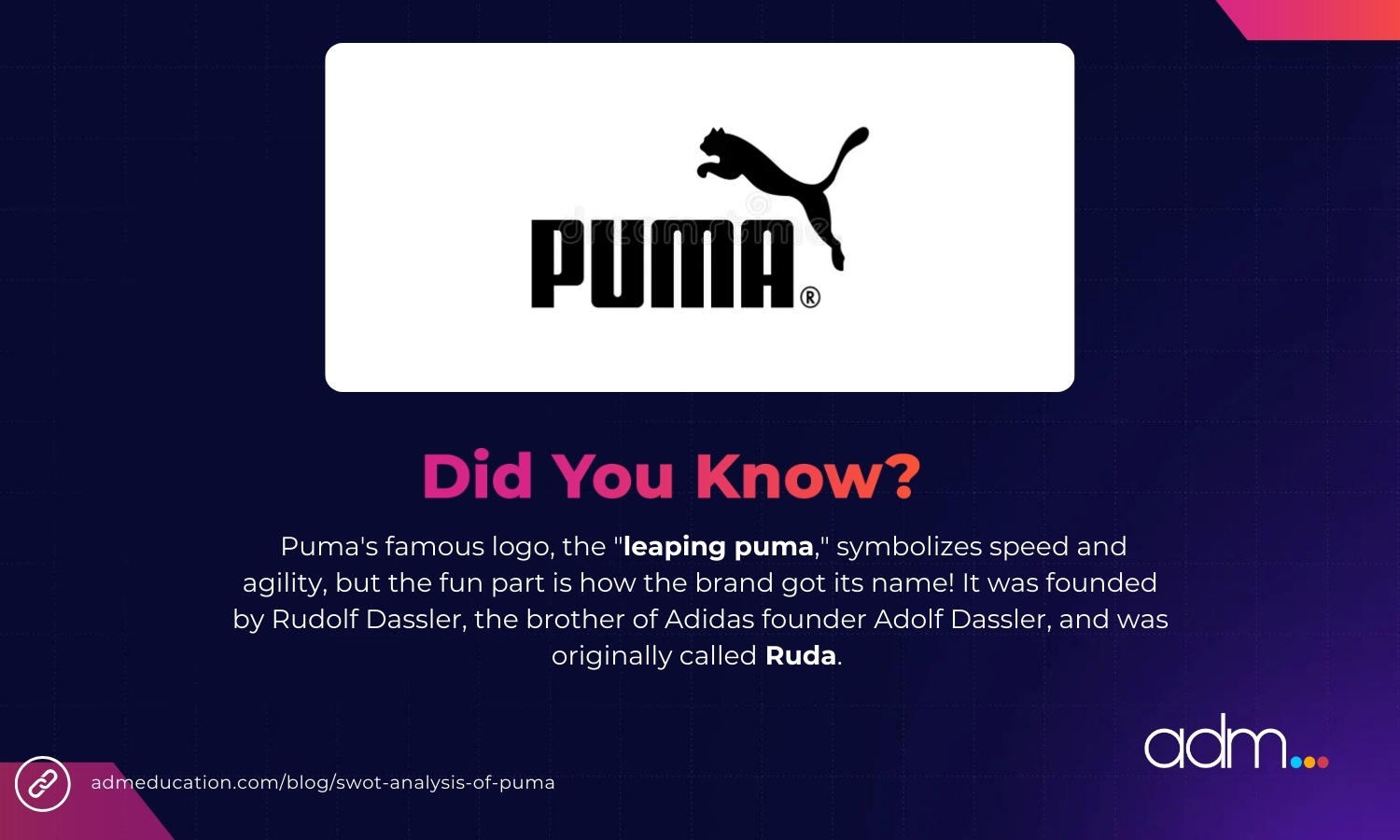Puma is a global leader in relaxation and athletic footwear and gears. Since its inception, the company has been connected with different athletes and sports occasions that boost its financial performance and brand enhancement.
Let’s see more information about the SWOT analysis of Puma and it is in detail.
About Puma
Rudolf Dassler started Puma in 1948. The company’s rapid Innovation and strategic collaborations are attracting young customers with its footwear products along with its two different category types. The company is very instrumental in offering cutting-edge products in footwear and accessories.
Puma makes use of innovative marketing strategies to drive itself and bring brand awareness. The company distributed its products through different channels like third-party retailers, E-Commerce platforms, and much more. Today the company has its proud presence in 100+ countries across the globe.
Puma at a Glance
| Founder | Rudolf Dassler |
| Year of Establishment | 1948 |
| Annual Revenue (as of FY24) | €8.465 billion |
| Net Profit (as of FY24) | €353 million |
| Origin | Herzogenaurach, Bavaria, Germany |
| Type of Company | Societas Europaea |
| Total no. of employees | 18,071 |
| Total assets (as of FY24) | €6.772 billion |
SWOT Analysis of Puma
SWOT analysis is a very effective strategy that helps companies evaluate the threats, opportunities, drawbacks, and strong points of their business. It also helps the external as well as internal elements that decide the success or failure of the venture.
Let’s now move ahead to the SWOT analysis of Puma.
Strengths of Puma
Strengths are one of the essential elements of this analysis which determines the plus points of the company.
Strong brand position
Puma is an internationally known brand having a long history in the sportswear market. The company has positioned itself as a strong brand since its inception and has been attracting numerous customers and gaining a competitive edge in the market with its brand recognition.
Diversified portfolio
Puma offers a wide range of products accessories and footwear serving different sports and lifestyle choices of people. This kind of diversification helps the company grab a big customer base and mitigate risks related to over-dependence on a particular product type.
Consistent innovation
One of the strengths of Puma lies in its consistent innovation in designing and state-of-the-art product technology. The company usually invests in R&D to improve product performance.
Visionary Collaborations
The company has established successful partnerships with top sports teams, athletes as well as designers. This kind of strategic partnership and collaboration enhances Puma’s brand image while increasing its sales and its product appeal.
Worldwide network
Puma has a great distribution network across the globe involving e-commerce platforms, third-party retailers, and more. Such kind of network helps the company reach customers across the globe and also adjusts to the changing market conditions.
Sustainability & CSR Campaigns
The company is highly committed to its sustainability and includes business strategies that give optimistic feedback from socially focused customers.
Excellent financial graph
Puma has witnessed constant growth in the last few years which shows its rigorous marketing strategies are quite effective and are inclined towards the market conditions.
Weaknesses of Puma
Below are the weaknesses of Puma –
Limited market stake
Even though Puma is a very popular brand it has a very small market share as compared to the other industry giants like Adidas and Nike. This factor limits the capacity of Puma to influence market trends and makes it the biggest weakness of the company.
Minimal response to market trends
As compared to its competitors Puma has been quite slow to adjust and capitalize on the developing market trends like digitalization. It results in overlooked options as well as downsized profits.
Fixed market presence
Puma has a very limited presence in developing markets like India and China which is less than that of the competitors. These development markets have great growth opportunities and Puma has a very limited presence that may restrict the capacity to expand its footprints.
Uneven marketing strategy
Puma has been very successful with its innovative marketing campaigns. But the company’s marketing strategy has been minimally consistent which may impact the brand perception as well as loyal customer base.
Opportunities for Puma
Below are the opportunities for Puma that should be emphasized.
Expansion in developing markets
There is a high potential growth for developing markets like Southeast Asia, China, India, and more where the requirement for sportswear is on the rise. Puma can focus easily on acquiring this market and developing market share in these regions.
E-Commerce growth
The e-commerce market across the globe is bulging and offering different opportunities for Puma to enhance its online presence and approach customers. Investing properly in user-friendly suffering experiences and targeted digital marketing campaigns along with smooth logistics helps the company take the trends.
Sustainability initiative
Today social as well as environmental concerns are increasing and customers are getting more inclined towards it. In this scenario, Puma can devote itself to genuine corporate social responsibility and sustainability campaigns for a great future. It will involve using sustainable materials while minimizing the environmental effects of the supply chain and community programs.
Innovative technology
Puma can laboriously fund advanced R&D to create innovative products. It can be done by leveraging advanced technologies and elements that may help differentiate the brand from the rest of the market leaders and can also appeal to new customers.
Customization
Customers are increasingly becoming demanding for personalized products. Hence, Puma should invest in technology that allows personalization keeping their customers happy and satisfied.
Threats to Puma
Threats are those areas that need to be taken care of. Here are the threats to the world-class leader in the sportswear sector – Puma.
Severe competition
The company operates in a highly competitive industry sector having top players like Adidas that also dominate the market. Small as well as new-entry companies contribute to the competitive landscape of the company while putting huge pressure on the company’s profitability and market share.
Economic situations
The global economy changes customer spending on items like sportswear. It can reduce the demand for Puma’s products and may also hurt the company’s revenue and sales.
Supply chain disturbances
Puma depends heavily on the supply chain across the globe having different products manufactured in various countries. If the supply chain is disrupted due to natural disasters, political issues, or trade disputes it can increase the production cost or may result in shortages of products.
Changing customer choices
The sportswear industry is run by customer choices and friends which may change rapidly at any time. Therefore, Puma should continuously invest in innovation to stay competitive in the market.
False products
The market is very susceptible to first products that damage the brand reputation and may also impact the sales of the company negatively. It should also protect the intellectual property and metric necessary measures to fight counterfeit products.
Top Competitors of Puma
Here are the top 5 competitors of Puma –
- Nike: It is one of the most influential sportswear brands offering different products including apparel, footwear, equipment, and much more related to sports and lifestyle.
- Adidas: It compacts directly with Puma for various categories including accessories apparel footwear having a strong presence in performance and lifestyle sections.
- Reebok: It is also a significant competitor to Puma in the fitness and sportswear market offering different products like apparel, footwear, and equipment.
- New Balance: This global footwear brand is among the most popular and recognized American companies that deal in high-quality athletic and innovative sports shoes.
- Under Armour: It is also a well-known American brand providing different products for apparel, footwear, and related accessories.
Conclusion
Puma has been implementing legacy and innovation to be at the forefront in the lifestyle and athletic wear market. It has set itself as a distinguished player in the truly dominated market with its amazing marketing strategies, strong financial performance, and sustainability initiatives.
Nevertheless, supply chain disruptions, market share enhancement, and quickly changing consumer choices need to be focused. The company is growing opportunities in developing markets life at leisure and eCommerce may combine with its dedication to sustainability and technology.
Janardan Das is a seasoned Growth Lead with over five years of experience in digital marketing. He specializes in crafting effective marketing strategies, including SWOT analysis and digital marketing courses, to help businesses thrive in the competitive landscape. He is passionate about sharing his knowledge and insights, empowering others to succeed in their marketing endeavors.





